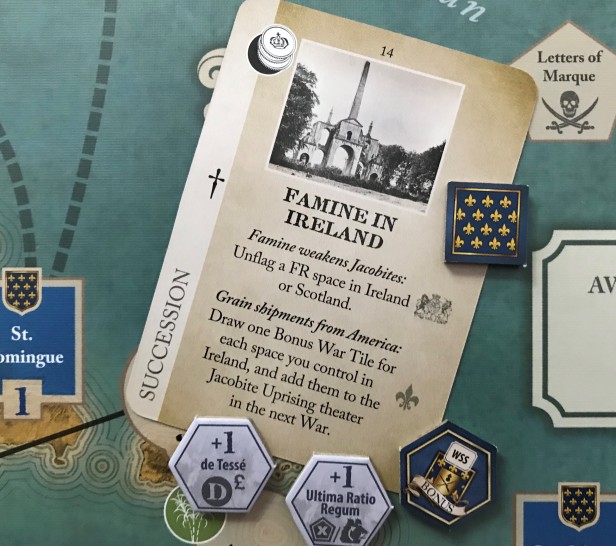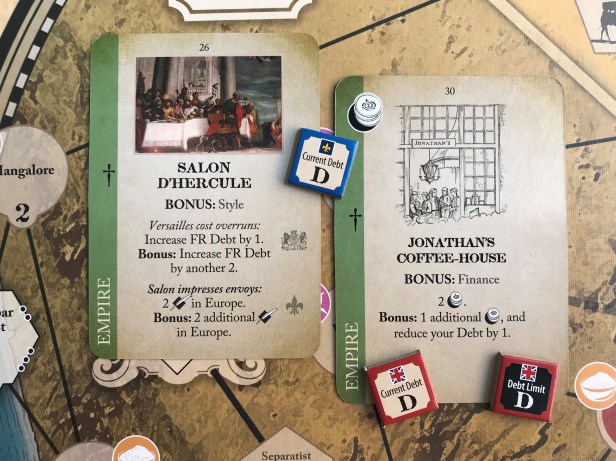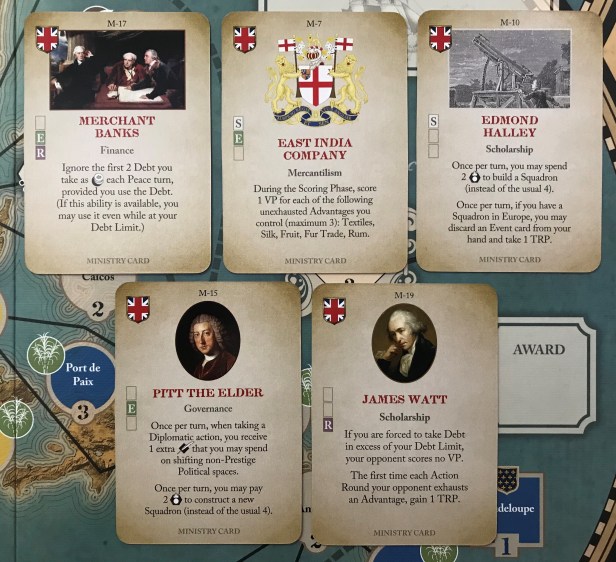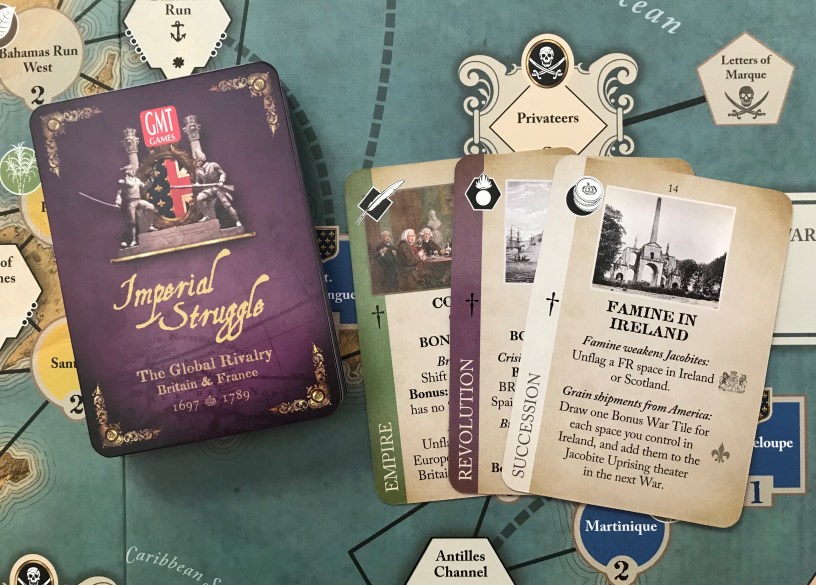We played Imperial Struggle a few weeks ago and the game is even better than it’s predecessor Twilight Struggle. Very different, but better. I didn’t think that was possible but it is. I still like TS a lot but this game fills a whole new niche and I have really enjoyed exploring it. Imperial Struggle deals with what historians refer to as the Second Hundred Year’s War and covers the period of 1697 through 1789 stretching over four different wars. The game uses cards and Investment Tiles to allow the player to take various actions that change their fortunes across the globe with diplomacy, economic growth, and if all else fails war. Players will score Victory Points from the domination of Regions, controlling various Markets and from victory on the field of battle. There are so many options and strategies available in this game that it makes for a very deep and lasting experience that only gets better with time and more plays.
In Action Point 1, we covered the map focusing on the different Regions and Sub-Regions and the various spaces, boxes and lines located in each. In Action Point 2, we examined the very interesting limited action selection mechanic using the Investment Tiles and the Advantage Tiles that enhance them and what that means for the player and their efforts. In this Action Point, we will take a look at the various Event Cards and Ministry Cards to get an idea for how these fit into the design.
Cards in Imperial Struggle
Before we dive into the two different types of cards, I want to point out how cards are used in the design. If you have played Imperial Struggle’s predecessor game Twilight Struggle, you know that cards take a major role in that game about the struggle for control of the globe between the United States of America and Russia. The cards have both Events and Op Points that can be used to take various actions and play revolves around managing the players hand of cards. The cards are used very differently in Imperial Struggle though and can best be classified as assisting the game but not driving it. Furthermore, the cards are tied directly to the Investment Tiles which are the main engine of the game. If you remember from our last post in this series, when a player takes an Investment Tile, they may take all of the actions on the tile in any order, except that if the tile allows an Event to be played, the Event must happen before any other actions are taken.
Event Cards
Event Cards are the basic element of the game that injects the historical timeline into the gameplay. The Event Deck contains cards that represent different historical events that can benefit one side or the other. When play progresses into a new Era this will trigger the addition of new Event Cards to the deck. The starting cards for the players are those that are marked with a white colored bar along the left edge of the card with the word SUCCESSION printed at the bottom left of the card. Then follows the EMPIRE cards and finally the REVOLUTION cards. At the start of each turn, players will be dealt 3 Event Cards.

One of the more interesting design choices revolving around the Event Cards is that the cards will typically display two versions of the same Event, one that is pro-French while the other is pro-British. One of the Events is the actual historical event as it happened and how it effected the struggle, while the other is a what-if type scenario that adds in some interesting ahistorical happenings. I really like this aspect as it is kind of like playing that game “2 Truths and 1 Lie” as you don’t really know which one is the historical version and as such you have to do some research to find this out. On these cards, the top section is always the pro-British Event while the bottom is the pro-French. A player may not play the version of the Event that is associated with their opponent. Some Event cards show only one version of the Event and these are played the same way by both sides.

Most of the Event Cards also show a Bonus Condition. These Bonus Conditions will provide the player an extra benefit if the Bonus Condition is met when the card is played. Along those same lines, some Event Cards have restrictions that may prohibit the card from being played. Some Event Cards show a specific investment type and those Events cannot be played unless the selected Investment Tile has an Event symbol and its Major Action matches the Event’s investment type. So playing these Event Cards can be a challenge as you have to work toward being able to play them in some instances. But, this planning assists the player in taking a strategy and trying to make their chosen actions more powerful and rewarding.
The Bonus condition is typically, but not always, met with the Ministry Cards that a player has played face down at the beginning of their turn. For example, in the below picture you will see that Jonathan’s Coffee-House has listed as its Bonus condition Finance. If the player has a facedown Finance Ministry Card they will then gain the bonus. They then have to reveal that Ministry Card. Normally, the Event Card provides 2 Economic Action Points but if the Bonus Condition is met the player will receive 1 additional Economic Action Point and also will be allowed to reduce their Debt by 1. I have found that these Bonuses are very important and can make the difference between a good turn or a great turn. I wouldn’t encourage anyone to spend a lot of time choosing their Actions each turn around the Bonus Conditions though as this could lead to you not doing those things that are best suited for your strategy and the current board state. But when all things align and the Bonus Condition is meat it can be really great and make a big difference.

The process of using an Event Card though is very specific and the players must follow these steps in strict order with exactness. When the Event Card is played, the players should first check the Bonus Condition. If the Condition is satisfied with the current state of the game, then the player will be entitled to receive both the standard and bonus effects from the played Event. If not, then only the standard effect is received. What this order really reinforces is that players cannot use the standard Event effect to satisfy the Bonus Condition and then collect the Bonus Effect. This Bonus Condition must be satisfied at the moment the Event is first played.
Also, when an Event is played, the player must take the standard effect before taking the Bonus Effect, and must fully resolve all Event effects before proceeding to the Actions on their Investment tile. The final point that you must keep in mind is that each Event Card is removed from the game once played. This is a key difference between Twilight Struggle and Imperial Struggle as in TS only certain cards were removed when stated.
Ministry Cards
Each player has their own unique 13 card deck that is referred to as the Ministry Deck. The Ministry Cards are what make each faction unique and brings in some asymmetry to the design. These Ministry Cards are designed to reflect each nation’s important policies, trends, and individual personalities that can be used to shape a players strategy and how they want to go about defeating their opponent.

Once played, a Ministry Card will remain face down on a players board until its owner uses any of its capabilities. These Ministry Cards can only be revealed by players on one of their Action Rounds. During the first Ministry Phase of each new Era, players will get the opportunity to update their Ministry Cards that are played on their boards. This means that you can remove previously played Ministry Cards that are from a previous Era and play out Ministry Cards that match the new Era. Each player will always get to play two Era correct Ministry Cards and then places them face down on their boards.

If you look closely at the Ministry Cards, you will notice that they are tied to one of three different Eras including SUCCESSION denoted with an S, EMPIRE denoted with an E and REVOLUTION denoted with an R. After Minstry Cards are initially played, the players may replace one or both face down Ministry Cards with other eligible Ministry cards. These Ministry Cards provide special abilities and can be used during one of their owner’s Action Rounds or at the end of the turn if the effect states on the card that is when it occurs. These Ministry Cards can also score VP during the Scoring Phase but in order to do so must have been revealed during an Action Round.
If a Ministry Card’s text indicates that its ability can be used only once per turn, then the player should place an Exhausted Marker on the card when the card is used, similar to how players use up an Advantage Tile each round. Some Ministry cards have multiple abilities, which can be used
and exhausted separately from one another.
Earlier we talked about Bonus Actions and how they are connected to these Ministry Cards. This connection is denoted by one of five different Keywords including Finance, Mercantilism, Governance, Style, and
Scholarship. As we discussed, some Event Cards list a keyword as their Bonus Condition. The Bonus Effect will be triggered if the player playing the Event reveals, or has revealed in an earlier Action Rounds, a Ministry Card with that keyword. Some Ministry Cards will also grant bonus Action Points, when a specific type of Action is taken.

How do players gain new Ministry Cards and how can they trade them out?If the current turn is the first Peace Turn of a new Era, which means it is Turn 1, 3 or 5, each player will take all of their Ministry cards including any that might be in play, and selects two of them from those that match the current Era. They then place them them face down on their player board. Also, if the current turn is not the first Peace Turn of a new Era, players may replace any face-down Ministry Cards that have not been revealed with eligible unused ones from the current Era. This is very key and shows the thought that went into the design to make it a continual struggle to get ahead by changing you strategy based on the board state or Events that you might have in your hand and also provides an opportunity for the losing player to get back into it. The players can in essence change the course of their strategy and try to do something differently in order to gain an advantage over their opponent.
This design is so good as it tries to tie in so many different moving parts and does so seamlessly to create a divinely interesting and strategic play experience. I love that the cards in Imperial Struggle are used completely differently than Twilight Struggle. They supplement the actions that players take as they choose their Investment Tiles and don’t drive the action. As we have played this one, I have thought about how easy it would have been for Jason and Ananda to simply use the same tried and true method of cards from Twilight Struggle. I mean, it worked, and plays very well and really is one of my most favorite games of all time, but now comes this implementation of the same type of tug of war struggle between empires but they use a new mechanic and introduce a new way of playing the game. I think that is just about the coolest thing ever and really give the dynamic duo a tip of the cap as they have really outdone themselves with the depth and ingenuity of Imperial Struggle.
In Action Point 4, we will take a look at the Game Sequence including the differences between Peace and War Turns, Action Rounds and the different actions available including Diplomatic, Military and Economic Actions.
-Grant
